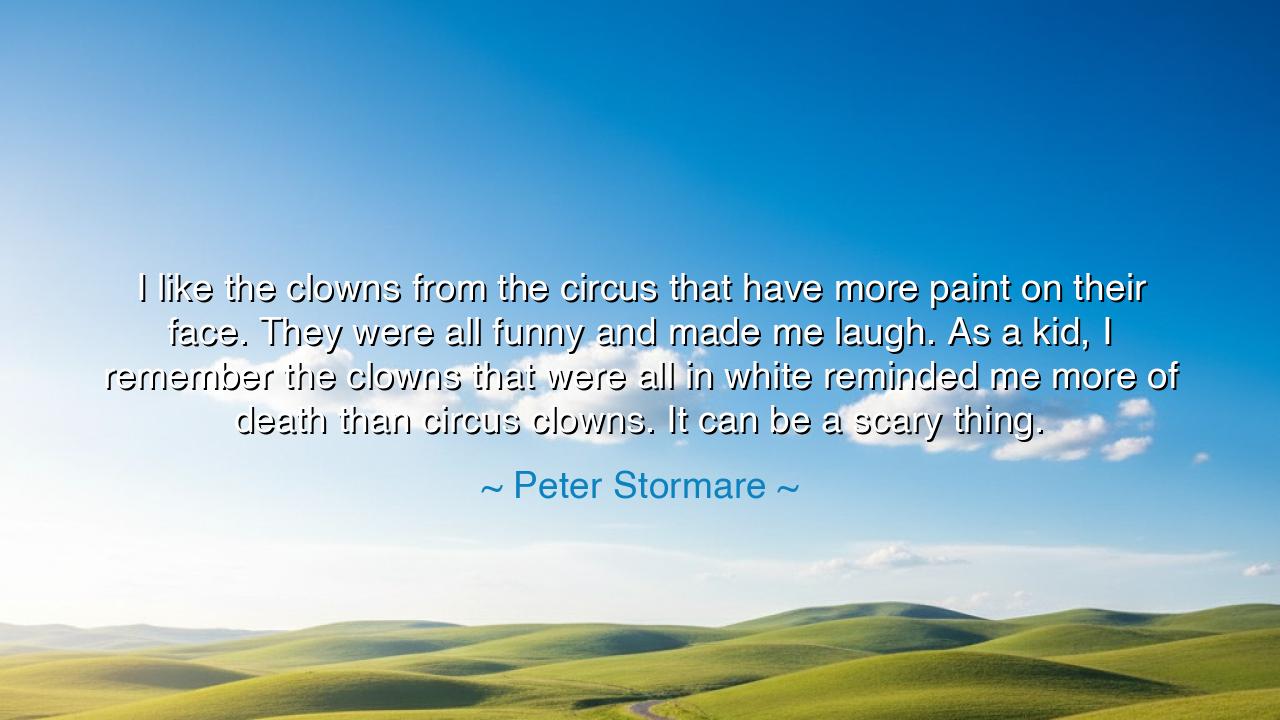
I like the clowns from the circus that have more paint on their
I like the clowns from the circus that have more paint on their face. They were all funny and made me laugh. As a kid, I remember the clowns that were all in white reminded me more of death than circus clowns. It can be a scary thing.






The words, “I like the clowns from the circus that have more paint on their face. They were all funny and made me laugh. As a kid, I remember the clowns that were all in white reminded me more of death than circus clowns. It can be a scary thing,” come from Peter Stormare, the Swedish actor known for his haunting performances and deep, introspective mind. Though his words speak of clowns, they reach into something far deeper—the delicate balance between joy and fear, between the masks we wear for laughter and the shadows that linger beneath them. In this reflection, Stormare touches upon one of the oldest truths of art and life: that light and darkness are forever intertwined, and that what brings us laughter may stand perilously close to what reminds us of mortality.
In the style of the ancients, we might say that Stormare speaks not of painted faces, but of the masks of the soul. The clowns with bright colors and exaggerated smiles represent life’s celebration—the fullness of spirit that dances despite its absurdities. They are chaotic, flawed, human, and therefore comforting. Yet the clowns “all in white,” pale and still, evoke something colder: the perfection that borders on emptiness, the purity that hints at finality. To the child that Stormare once was, these pale figures whispered of death, not joy. For death, too, wears a mask—one of silence and stillness. His words, though tender, remind us that laughter is precious because it stands in defiance of the stillness that awaits all living things.
In the old days, philosophers and playwrights knew this duality well. The ancient Greeks gave us two masks—the smiling face of comedy and the weeping face of tragedy—and taught that both are parts of the same human drama. Stormare’s insight belongs to this same lineage. The “painted clowns” of the circus, wild with color and motion, embody the comic mask—the pulse of vitality. The white clowns, solemn and spectral, embody tragedy—the reminder that life, for all its color, will one day fade. To him, the painted faces symbolized vibrant imperfection, while the pale ones whispered of the void. And in this contrast, we see the eternal tension that defines all existence: we laugh to forget death, and yet every laugh reminds us that we are alive for only a moment.
Consider, too, the life of Charlie Chaplin, the great silent clown of the modern age. Beneath his comedic genius lay deep melancholy. His “Little Tramp” character stumbled through a world of hardship, yet his resilience made millions laugh. Chaplin once said, “To truly laugh, you must be able to take your pain and play with it.” In this, he embodied exactly what Stormare describes—the brightly painted clown who hides sorrow beneath laughter, who knows that the color on his face is armor against the pallor of despair. The white-faced clown, in contrast, has lost the ability to play with his pain; he has become its embodiment. Thus, humor becomes an act of courage, a rebellion against the fear of the inevitable.
Stormare’s reflection, simple yet profound, also reveals how the imagination of a child perceives truth more directly than reason ever could. To a child, symbols are alive: color means joy, and the absence of it means fear. The white-faced clown becomes a ghost, a harbinger of stillness amidst motion. The child’s instinct sees what the adult forgets—that laughter needs life’s color to exist. To remove that color, to strip away the excess, is to step closer to the coldness of silence. In this, Stormare speaks not just of childhood memories, but of the spiritual need for vibrancy and imperfection. We are meant to live in color—to stumble, laugh, and err, not to become flawless and still.
The wisdom of this quote extends beyond art or childhood. It is a meditation on how we face fear and mortality. We can choose to be the brightly painted clown—alive, foolish, defiant—or the pale clown, who watches from the edge of life, frozen in contemplation of the end. The painted clown knows that life is brief but chooses laughter anyway; the white clown knows it, too, but has already surrendered to sorrow. Thus, Stormare’s memory is not merely nostalgic—it is a choice, a philosophy: to live with color, even when death waits in the wings.
And so, my child, the lesson is this: fill your life with color, with laughter, with movement. Do not fear the absurdity of being alive; embrace it. Let your laughter echo through the corridors of fear, and paint your own face—figuratively or literally—with the bright colors of courage. Do not strive for the sterile perfection that resembles death; instead, delight in the flawed, the lively, and the loud. Remember that the paint you wear—the creativity, humor, and humanity within you—is what separates you from the cold stillness of the white mask.
For as Peter Stormare reminds us, the world is both circus and graveyard, both laughter and silence. It is up to you to decide which face you will wear before the curtain falls. Choose, then, the face of color and life—the clown who laughs at his own foolishness and, by doing so, conquers the fear that lies beneath. For it is through laughter, painted boldly against the darkness, that we prove ourselves most alive.






AAdministratorAdministrator
Welcome, honored guests. Please leave a comment, we will respond soon